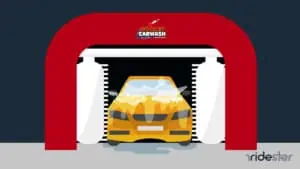Key Takeaways
- Choose installation method: hardwiring for constant power or power adapter for ease.
- Mount dash cam centrally for stability and unobstructed view.
- Route power cable neatly using trim tool or credit card for a clean setup.
- Connect to power, making final adjustments to ensure wide, clear view.
Choosing the Right Dash Cam Installation Method
A dash cam needs a power source to work, so you can either use a power adapter or hard-wire the cam to pull power from your car’s fuse box.
The problem with hardwiring is that it needs some technical skills and a hardwiring kit. If you don’t know your way around the fuse box, you may struggle while doing it. On top of that, the dash cam will be getting constant power, which may run down your vehicle’s battery.
At the same time, it’s the best way to ensure your dash cam stays on at all times, even when the car is parked.
Instead of hardwiring, you can use a power adapter, like the auxiliary port or cigarette lighter in your car. All you have to do is plug the power cable into the camera and the other end into the port, so installation is out of the way.
This is the best method to choose if your car is on a lease or if you don’t have enough technical expertise for hardwiring.
However, using the cigarette lighter to power your dash cam means that it’ll turn off when the engine isn’t running. That’s unless your car has an always-on cigarette lighter, which isn’t ideal either because it won’t detect when the voltage is too low.
So, your car battery may get drained if you leave the dash cam on too long. Or, you’ll need extra SD cards to increase the cam’s recording capacity!
It’s better to turn the cam off overnight if you want to avoid draining the battery.
Preparing for Installation
If you’re installing the dash cam via hardwiring, here’s everything you’ll need:
- Your car’s user manual
- Hardwiring kit
- Pliers
- Zip ties
If you’re connecting it to the cigarette lighter, you’ll only need suction cups or adhesive pads. For routing the cable, you may also need a trim tool or a credit card.
Now that you have the tools ready, remember to prepare your car for installation. Clean the windshield and make sure it doesn’t have any debris that may end up on the adhesive pads.
Tutorial: Installing a Dash Cam with a Power Adapter
Here’s how to install a dash cam using your car’s cigarette lighter:
Step 1: Choosing the Best Placement for Your Dash Cam
Installing the dash cam isn’t only about connecting the plug to the port. You also have to determine where to mount the camera.
Here’s what to prioritize when choosing the position: stability and safety. The cam needs to be stable enough and secure in its place, and it shouldn’t be obstructing your view for the sake of your safety.
The best place to mount it is right at the center behind the rear-view mirror.
Step 2: Mounting the Dash Cam
Now that you have the cam’s mounting place ready, it’s time to mount it. You can use either suction cups or adhesive pads, but I recommend adhesive pads because they don’t come off. A suction cup may come undone in the event of an accident. Only choose it if you might change the cam’s position later on.
All you have to do is stick the adhesive pads on your windscreen and attach the cam. Keep it pressed over the adhesive mount for 10–20 seconds to keep it secure.
Step 3: Routing the Power Cable
Now that you’re done mounting the cam, you can plug it in and call it a day, but you don’t want those ugly dash cam cables dangling and obstructing your view. That’s why you’ll route them.
If you’re lucky enough to have one of those cameras that don’t require cords, you won’t need this step.
The best way to route the cable is to run it under your car’s trim panels using a trim tool. Or, you can run it along the headliner and the car’s pillars, then down to the lighter.
Step 4: Connecting to Power and Final Adjustments
Now, all that’s left is to connect the cam to power by plugging it into the cigarette lighter’s port. Using the cam’s screen, make sure the view is wide enough for you. If the view needs adjustments, now is the time to do it.
Tutorial: Hard-Wiring a Dash Cam
If you’re hardwiring your dash cam instead of connecting it to a power outlet, here’s how to do it:
Step 1: Identifying a Suitable Fuse Slot
Using the user manual or online information, locate your car’s fuse box and remove the panels to get to it. Now, you need to determine which fuses are constant and which ones are ignition-switched. To do so, use a circuit tester.
Choose an ignition-switched fuse because that means it’s only on when the ignition is on, which means both safety and continuous recording.
Step 2: Connecting the Hardwiring Kit
Now, read the labels on the cables of your hardwiring kit to determine which one goes where. The yellow one usually goes into the ignition-switched fuse, but it’s always better to make sure.
Remove the key from the ignition, then remove your chosen fuse using a pair of pliers. Install it into the add-a-fuse kit, then plug the whole thing into the slot you emptied earlier.
Next, you need to ground the other end of the wire to your vehicle.
Remove the lower kick panel to reveal the ground point closest to the fuse box, then remove the bolt and attach the ground lug (it should be in your hardwiring kit).
Lastly, bundle the remaining cable and secure it using a zip tie, then keep it hidden behind the kick panel.
Step 3: Routing and Hiding Wires
To route the wire, you can either hide it through the headliner and along the pillars or under your trim lines.
While doing so, remember to leave a bit of a slack down to the fuse box.
If you’re routing it using the headliner and pillars, you can tug on the trim line of the A-pillar, and you’ll reveal a gap that’ll keep the cable concealed down to the fuse box.
Step 4: Testing and Troubleshooting
Now that you’re done, turn your key in the ignition and check the dash cam. It should turn on and begin recording on its own. In that case, you can return everything to its place and call it a day.
If the camera doesn’t work, you may have used an incorrect ground or installed the add-a-fuse incorrectly. Or, the issue may be as simple as a loose wire in the add-a-fuse.
Best Practices for Dash Cam Installation
One of the most important things to consider when installing your dash cam is making sure it doesn’t obstruct your view. It’s a common mistake to tilt it a bit to the left and right and let it take a good chunk of your front view, but you have to be careful if you don’t want to compromise your driving.
You’ll also want to check your state laws when it comes to dash cam basics. In some states, it’s illegal to record audio inside your vehicle when you have passengers, and in others, it’s illegal to mount anything on the windscreen. Always check your local laws before installing it to be on the safe side.
Frequently Asked Questions
Is a Mirror Dash Cam Different?
Yes, people often confuse them together, but mirror dash cams are different. They’re mounted on the rear-view mirror instead of the windscreen and often have a rearward view to help you reverse, park, etc.
Does a Dash Cam Have to Be Wired Into a Car?
No, it doesn’t, though wiring it is the best way to ensure that it’s always on. You can alternatively connect it to the cigarette lighter or auxiliary port.
Is There a Dash Cam Without Wires?
Yes, the market offers plenty of wireless dashcams with batteries. However, they’re often pricier than their counterparts.
How Much Does it Cost to Install a Dash Cam?
If you’re connecting it to your cigarette lighter, it costs nearly nothing. You’ll only have to buy adhesive pads. If you’re hardwiring it, you’ll pay for a hardwiring kit, which shouldn’t cost more than $20–$30.
Conclusion: Ensuring a Successful Dash Cam Installation
Whether installing your dashcam through a power supply or hardwiring, remember to choose its mounting position carefully and make sure the view is wide enough. Take your time with the installation, especially if you’re hardwiring, because any mistake can be hard to reverse.
If you follow the steps above and get the right tools, the installation process should be smooth sailing.





